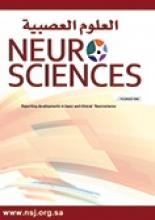Abstract
OBJECTIVE: The aim of the current study is to assess plasma levels of oxytocin and vasopressin in autistic children. Also, to correlate plasma levels of those neuropeptides to the degree of autism and age of the affected child. An additional aim is to investigate the role of Pitocin induction in the genesis of autism.
METHODS: The study was conducted in Riyadh, Kingdom of Saudi Arabia between September 2003 and April 2004. Seventy-seven autistic child from Riyadh area participated in the study, with the confirmed diagnosis according to DSM-IV diagnostic criteria of autism. The parents/guardians filled a simple related questionnaire, then plasma oxytocin and vasopressin levels were measured in autistic and control children.
RESULTS: Results showed a statistically significant lower plasma level of oxytocin and vasopressin in autistic children as compared to controls. There was no significant correlation between the degree of autism, or the age of the affected child and plasma levels of oxytocin or vasopressin. There was a higher incidence of Pitocin-induced labor among autistics as compared to normal.
CONCLUSION: Data in this study prove that oxytocin and vasopressin plasma levels were reduced in autistic children which, might be related to abnormal social behavior in autistic children. Higher rates of Pitocin induction were found among the autistic group. The data supports an association between exogenous exposure to oxytocin and neurodevelopmental abnormalities. Further clinical studies are recommended to explore the possible therapeutic effects of oxytocin and vasopressin in autism.
- Copyright: © Neurosciences
Neurosciences is an Open Access journal and articles published are distributed under the terms of the Creative Commons Attribution-NonCommercial License (CC BY-NC). Readers may copy, distribute, and display the work for non-commercial purposes with the proper citation of the original work.






